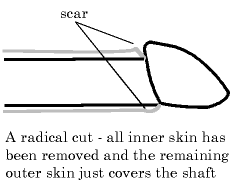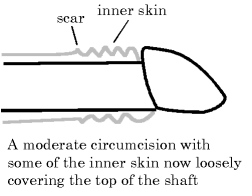
Circumcision - what exactly is it?
What does a circumcised penis look like
and how does it work?
Many men, and women, don't have a very clear idea of what the circumcision operation involves. If you have your appendix out, a specific thing is removed - there's no question of taking a little bit more or a little bit less. But the foreskin is not a defined entity, it is just the excess of the skin covering the shaft of the penis. Circumcision removes some of this loose skin, so that it can no longer hang in a fold over the glans, but leaves the knob wholly or partially exposed. How much, and which part, is removed is a very variable thing.
The Cut
If a lot of skin is removed the glans will be completely exposed and the remaining skin will be a close fit on the shaft. The technical term for this is 'radical' circumcision.

Sometimes less skin is removed; the glans is still fully exposed but the remaining skin sits quite loosely on the shaft, on which it is freely mobile. This is a 'moderate' circumcision and is recognizable by loose folds or wrinkles of skin on the shaft, often bunching up behind the edge (corona) of the glans.

Sometimes, particularly where older children are circumcised, so much skin is left that the glans is partly covered, though only loosely since there is no longer any constriction to hold the skin forward. This is referred to as partial or palliative circumcision, where the primary aim is to rectify a foreskin that is too long or too tight rather than specifically to expose the glans.
The other variable is where exactly the surplus skin is removed. Some surgeons remove the inner, thin skin more or less entirely, so that the scar is right at, or just below, the base of the glans. (This was once regarded as an essential feature in traditional Jewish circumcision). In this case, how much of the outer skin is also removed will determine how 'radical', or thorough, the circumcision will be. Others, however, leave much of the inner skin, taking mainly outer skin; the scar is then some way down the shaft and what was formerly the inner skin now covers the upper inch or so of the shaft.
In a partial circumcision it is important that the scar from the operation lies over the shaft of the penis. If it lies over the glans it can contract, forming a tight ring over the glans and creating a worse phimosis than before. In this sort of circumcision it is therefore essential either to leave a lot of the inner skin or to remove it completely, so that the scar is directly below the glans, and the loose skin is all outer skin. The latter is the common approach since the final position of the scar is totally predictable.
When a circumcised penis gets erect any wrinkles in the skin will straighten out. If there is no loose skin to spare, the skin will stretch, but it is very stretchable. (The skin has to stretch just the same in an uncircumcised man if his foreskin does not retract with an erection.) If the circumcision is fairly radical, this stretching may pull up some hairy skin from the pubic region and scrotum on to the base of the erect shaft.
More about circumcision:
Circumcision is the world's oldest operation. It is shown in 5000 year old Egyptian pictures and texts, and was probably practised for millenia before that. It was traditionally carried out by indigenous people on every continent except (perhaps) Europe.